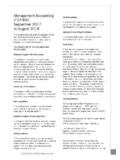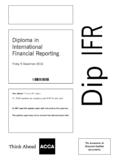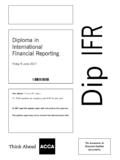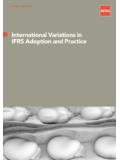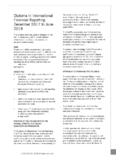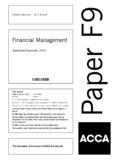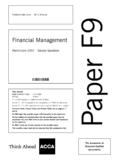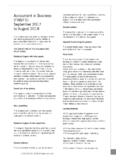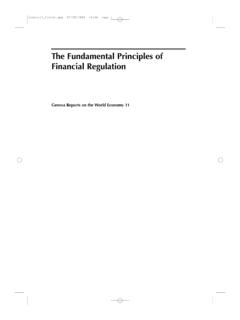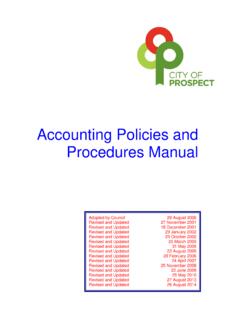Transcription of Answers - Association of Chartered Certified Accountants
1 Answers9 ACCA Certifi ed accounting Technician Examination Paper T8 (SGP)Implementing Audit Procedures (Singapore) December 2009 AnswersSection AQUESTIONS 1 10 MULTIPLE CHOICEPart Answer See Note Below1 C 12 D 23 D 34 B 45 C 56 B 67 B 78 C 89 D 910 C 10 Notes1 It is management s responsibility to prevent fraud within a company (option B) and there are auditor independence issues with regard to external auditors being involved in the preparation of fi nancial statements and in assisting management to improve reporting processes (options A and D). It should therefore be apparent that option (C) is When adopting a systems approach to an audit, the auditor seeks to rely on internal controls with a view to reducing substantive tests (option D).
2 In so doing the auditor will ascertain and record the client accounting systems (option A) however this characteristic is not unique to the systems-based approach. CAATs may be used irrespective of audit approach (option B) and the type of system (computer-based or manual) does not govern the approach to be adopted (option C).3 Options (A), (B) and (C) pertain to documents that are unique to the current year s audit engagement, consequently they should be fi led on the current fi le. A copy of the company s legal constitution (option D) would be of ongoing relevance to future audits and should therefore be retained on the permanent fi Management controls are those introduced by management outside the day-to-day routine of the system (options (2), (3) and (4)). Option (1) does not fi t into this category, it relates to the segregation of duties, a control that should be prevalent throughout a company s day-to-day A sale should be recognised as soon as goods have been safely despatched to a customer and every despatch should be accompanied with a goods despatched note.
3 Consequently, to obtain assurance about the completeness of sales, the auditor needs to be confi dent that all despatch notes have been recorded in the accounting system (option C). Checking that all sales invoices have been processed merely confi rms that all sales invoices have been processed (option B) and similarly the existence of authorisation controls merely provides assurance as to whether transactions have been authorised (option D). The existence of segregation of duty controls(option A) does not in itself provide assurance as to completeness of recording of sales The primary objective of a physical inspection of plant and equipment is existence (option B). Referring to options (A), (C) and (D), auditors may obtain corroborative evidence to support the ownership and valuation assertions when carrying out a physical inspection of such assets, but they should carry out other more pertinent tests to gain assurance in support of The procedures mentioned at options (A), (C) and (D) are all tests for understatement of inventory.
4 Option (B) is a test for overstatement in that the auditor is seeking to ensure that slow-moving and obsolete inventory lines have correctly been written down to the lower of cost and net realisable A wages master fi le must contain standing data which is of continuing importance for the processing of information and updating of the wages data fi le for each employee. Consequently the data items detailed at options (A), (B) and (D) are important items for inclusion in the fi le. The amount of cumulative statutory deductions to date (option C) is not standing data and should not be contained in the master fi It is generally recognised that all four elements listed at options (A), (B), (C) and (D) are those which an internal audit department should Confi rmation of the accounting convention used in preparing the fi nancial statements of a company is not a necessary component of a standard audit report (option C).
5 The components mentioned in options (A), (B) and (D) are all important and necessary B1 Country Co (a) The objectives of the purchases and trade payables system are: (i) To ensure that only necessary goods and services are procured by Country Co. (ii) To ensure that all goods and services procured are for the benefi t of Country Co. (iii) To ensure that goods and services procured are of suffi cient quality. (iv) To ensure that goods and services are procured on a timely basis. (v) To ensure that goods and services are procured on the best possible trading terms taking into account price and due payment date. (vi) To ensure that all purchase transactions are accurately and completely recorded in Country Co s accounting records. (vii) To ensure that any disputes with suppliers are settled to the greatest benefi t of Country Co.
6 (Full marks will be awarded for stating any FOUR of the above objectives) (b) I would ascertain the purchases and trade payables system of Country Co by: (i) Enquiry I would ask questions of management, supervisors and clerical staff about the system, for example, I would want to know which employees were responsible for what duties and to what extent internal checking procedures were in place. (ii) Inspection I would inspect any procedures manuals, which set out/describe the purchases and trade payables system. Similarly I would inspect the various detailed documents and records processed through the system including purchase requisitions, copy purchase orders, goods received notes, supplier invoices and credit notes and trade payables journals. (iii) Observation I would watch the various employees of Country Co, who are engaged in the procurement process carrying out their normal day-to-day activities including the processing of transactions and the performance of review functions.
7 (c) The purpose of a walk-through test is to confi rm the auditor s understanding and recording of the system under review. Having ascertained and recorded the accounting system, auditors can gain assurance that their understanding and recording of the system is accurate and complete by tracing a small number of transactions through the system. This should confi rm that there is no reason to believe that the system does not operate in the manner as understood and as recorded. (d) The following internal controls should exist over the procurement of manufacturing components by Country Co: 1 Ordering of Goods (i) Purchase orders should be raised by authorised purchasing offi cers in the company s purchasing department and authorised by the purchasing manager. Stringent physical controls should exist over purchase order stationery.
8 (ii) Authorised, budgeted expenditure holder (budget holders) of Country Co should initiate the procurement process by the requisitioning purchasing offi cers to raise purchase orders for forwarding to authorised suppliers. (iii) Sequentially numbered purchase orders should then be raised by the relevant purchasing offi cer on the best trading terms and authorised by the purchasing manager who should ensure that order details accord with the underlying requisitioning documentation. (iv) A copy of each authorised purchase order raised should be retained by the purchasing offi cer and further copies should be forwarded to the expenditure budget holder; the company s goods received section and the company s accounts department (trade payables ledger section). These should be fi led securely in numerical order by recipients.
9 2 Receipt and Return of Goods (i) All goods delivered by suppliers should be directed to the goods received department for checking by experienced and qualifi ed individuals as to the quality and quantity of goods received. (ii) Any goods delivered without reference to an authorised purchase order number should be refused. All other goods should be cross checked to the relevant purchase order number for quantity and quality, and details of each checked delivery deemed to be as per ordered should be entered on to a pre-numbered goods received note. Goods received notes should also show the date of receipt, the purchase order number and the name of the individual checking in the delivery. Originals should be fi led securely in number order and a copy of the goods received note should be forwarded to Country Co s accounts department and fi led securely in number order awaiting the supplier invoice.
10 (iii) Any goods received which are deemed to be of inferior quality to those ordered or in excess of quantities ordered should be immediately returned to suppliers along with a pre-numbered goods returned note, containing full details of the delivery and reason for the return. Goods returned notes should be prepared by individuals in the goods received section with copies being retained by both that section and the company s accounts department (trade payables section) fi led in secure sequential order awaiting credit notes from suppliers and appropriate follow 3 Trade Payables Invoices/Credit Notes (i) All trade payables invoices/credit notes received by Country Co should be directed to the trade payables section of the accounts department for marrying up to purchase orders and goods received documentation.
